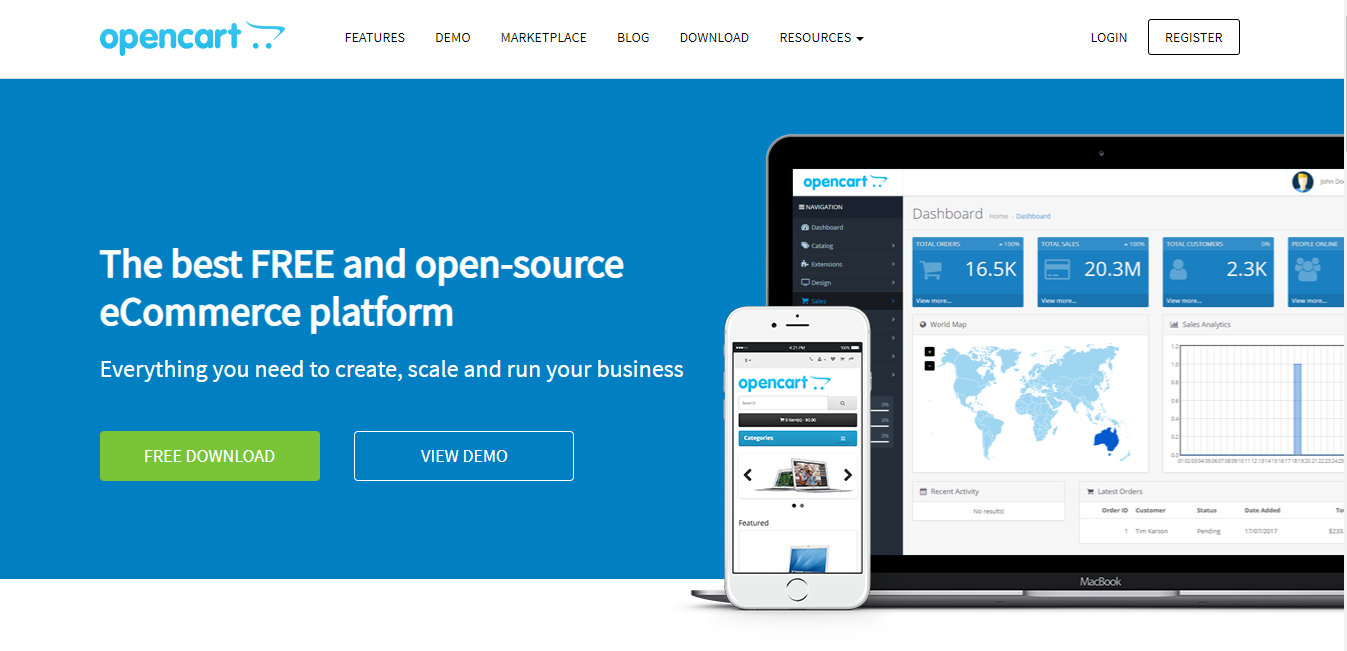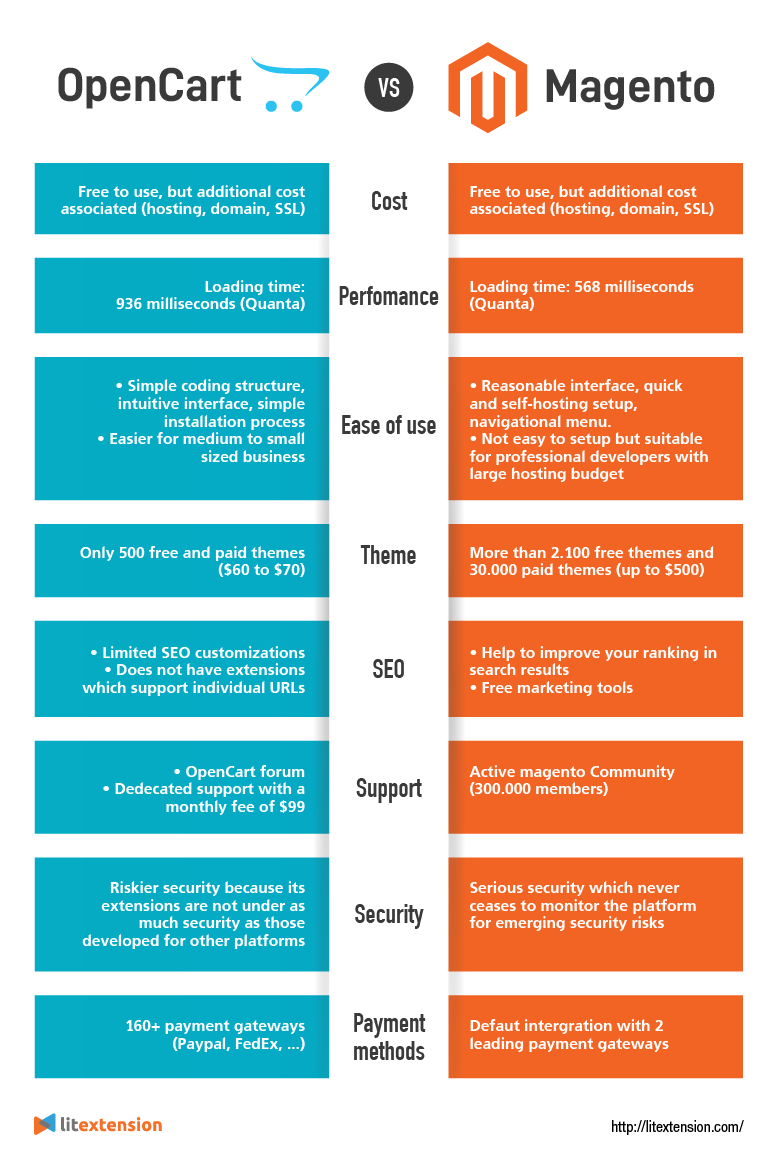When it comes to eCommerce platforms, there is no one-size-fits-all solution. Business owners just starting their online business may be bewildered by the number of various platforms out there in the eCommerce market.
OpenCart vs Magento (Adobe Commerce) are two of the biggest eCommerce platforms in the market. Both are extremely resourceful and when it comes to popularity, they are on equal footing. Users might be confused due to a bunch of questions, such as:
- Which is better OpenCart or Magento?
- Is OpenCart better than Magento?
- What is better than Magento?
- Is Magento the best eCommerce platform?
- Is OpenCart eCommerce any good?
That’s why making the right decision between them is a difficult task that many store owners are bound to face.
In this article, LitExtension is going to show you:
- An Overview of OpenCart, and Magento
- A comprehensive comparison between OpenCart vs Magento
- Why you might choose one of them over the other to build your eCommerce website
OpenCart vs Magento – Overview
What is OpenCart?

Among top Magento alternatives, OpenCart is a free open-source eCommerce platform developed on PHP/MySQL code, which is pretty similar to Magento. OpenCart is widely famous for its simplicity and user-friendliness. It has an easy-to-use administration dashboard to allow you to manage products, promotions, orders, and reports without requiring any technical expertise.
According to BuiltWith, OpenCart has empowered over 400,000 websites. Most of them are small and mid-size businesses in the U.S., Russia, the U.K., Ukraine, and Brazil.
What is Magento?

Owned by Adobe, Magento is undisputedly a king among open-source eCommerce platforms. It provides complete control over every aspect of your online store and high scalability with a lot of advanced features. With technical skills, you’ll be able to freely customize your store as you wish.
This platform has provided two key eCommerce solutions along with other products, namely Magento Open Source and Magento Commerce. Magento Commerce also has a managed and automated hosting version called Magento Commerce Cloud, which is an all-in-one solution built exclusively for high-sales enterprise-level merchants or medium-sized enterprises that are preparing to grow.
According to the statistics of BuiltWith, there are over 160,000 websites that are backed by Magento. It’s particularly popular among large enterprises, and the bulk of its users hail from the U.S., U.K., Netherlands, and Germany.
Need Help To Migrate Your Store?
If you intend to migrate OpenCart to Magento (Currently OpenCart to Adobe Commerce), LitExtension offers a great migration service that helps you transfer your data from the current eCommerce platform to a new one accurately, painlessly with utmost security.
OpenCart vs Magento – Similarities
Actually, OpenCart vs Magento are both open-source platforms developed in PHP. They are both superb eCommerce platforms with powerful features and tons of add-ons and extensions. OpenCart vs Magento also allows e-merchants to sell in multiple currencies and languages.
Their operating costs are quite similar. Downloading and installing OpenCart vs Magento is completely free of charge. However, since you are self-hosting your online store, these additional costs are required to run these two platforms: a hosting plan, a domain name, a good Magento or OpenCart template/design, necessary modules/ extensions, and an SSL certificate.
OpenCart vs Magento – Differences
Before jumping into details, let us show you all the key comparison components between OpenCart vs Magento via this infographic.

1. Cost
With respect to hosting, the fee an OpenCart user has to pay is lower thanks to the platform’s lightweight architecture.
Regarding extension, most of OpenCart’s premium extensions’ costs fluctuate from $10 to $489 a month. Meanwhile, Magento extensions can cost you around $50 to $500, with the Magento pricing varying from development agency to agency and the feature set of the extensions.
2. Performance
OpenCart Performance

According to an insightful study executed by Quanta, OpenCart response time results quite disappoint us. The time taken by an OpenCart website to load is 831 milliseconds – 1.6 times higher than Google’s recommendation for SEO. Product pages are also bad at a loading time of 910 milliseconds.
According to a study in 2012, slow load time has a negative impact on the shopping experience.
“Two-thirds of UK consumers (67%) site slow loading time as the main reason they would abandon an online purchase.” (Moth, 2012)
You can check out our OpenCart SEO tips to enhance your store performance. Customers nowadays are impatient. A slow website will cause you to lose customers. Therefore, this is definitely one of the factors that OpenCart needs to improve.
Magento Performance
The study shows that Magento’s online product page load time is 665 milliseconds, which is exceeding the level of fewer than 500 milliseconds, set by Google.
However, we find it acceptable and reasonable enough to keep clients until the end of the sales funnel.

The verdict: Magento undoubtedly beats OpenCart down with a much more impressive response time.
Need Help To Migrate Your Store?
Magento Adobe Commerce Migration is super easy with LitExtension. We help you transfer all your data from any current eCommerce platform to Magento 2 accurately and seamlessly with utmost security.
3. Ease of Use
OpenCart Ease of use
OpenCart is much easier for beginners to use and manage thanks to its intuitive interface and simple installation process. However, you still need to have basic technical knowledge of hosting, FTPs, security OpenCart upgrade, etc.
But luckily, there are multiple hosting optimized for OpenCart that will automatically set up the CMS for you without any skills of a web developer.
You can see the administration navigation of the dashboard. There, users easily navigate between the “Catalog”, “Extensions”, “Sales”, “System”, “Reports”, and “Help”.
Magento Ease of use
Magento is a robust, heavily laden platform, and is not a playground for an amateur. The installation process is very complicated, but don’t worry, as LitExtension has very detailed instructions on how to install Magento.
This platform provides its users with a very intuitive interface. You can easily find everything you need in the left bar of the dashboard. Once you’re digging into each dashboard tab, you’ll notice that Magento has a staggering number of options for almost all of its settings.

However, beginners sometimes have difficulty with Magento’s terminology, which leads to time-consuming Google searching. Customization is also a challenge with amateurs because they have to download extensions that cost some expenses and install them. The installation process is quite complicated, so you can refer to this guidance.
Honestly, if you are not conversant with software and technology, skip Magento entirely. It is going to take you more than a week or two to figure out how to make the system work. It’s only for businesses that are not on a shoestring budget.
The verdict: Regarding size, OpenCart is more perfectly suitable for empowering small businesses. It is able to get a business rolling within several hours of setting it up.
On the other hand, Magento is perfect for bigger online retailers. This platform can pose a serious challenge to merchants with little to no tech experience. Its installation process itself is a hassle if you’re not conversant with software and technology. However, if you are confident with your technical expertise, go for it because Magento is an ideal one for you. Fully customizable design, utter flexibility and a countless number of plugins – that’s how Magento proves itself.
4. Themes
OpenCart Themes
OpenCart offers only 500 themes, both free and paid (the paid ones cost from $60 to $70). All of the themes are slick, attractive, and sales-worthy. They provide different layouts, flexible customization, and cool features. Some of the outstanding OpenCart themes we can mention are Materialize Template, Journal…
The platform allows you to see how your website will look with different themes before you decide to pay for it. After that, you can easily and efficiently edit the themes with OpenCart’s Theme Editor.

Magento Themes
Magento gives you 2 free default themes – Luma (as a demonstration theme), and Blank (as a basis for custom theme creation), and they look too boring. To get something quality and good-looking, what you have to do is go to Magento Marketplace, which offers 17 themes, which cost you from zero to $500 for the starter package. You can also visit Alothemes for more visually stunning Magento themes.
Like OpenCart, Magento themes allow users to see how their website will look like with the theme before they decide to pay for it. Although Magento does not have many themes, you can get endless customization possibilities to design your store from scratch, thanks to Magento’s open-source nature.

Because of OpenCart vs Magento’s widespread popularity, a lot of third-party companies also provide themes for it. Besides these two platforms’ theme stores, you can find other amazing templates for OpenCart vs. Magento on Themeforest.
The verdict: In this round, OpenCart surpasses Magento with a large number of themes and affordable prices. In spite of the low cost, OpenCart allows users to integrate all the sufficient factors to make the look of your website stunning.
5. SEO & Marketing Tools
SEO is a tough race. To win it and get ahead of the competition, you need to have the best SEO weapons.
OpenCart SEO & Marketing Tools
A lot of users have unsatisfied experiences due to OpenCart’s limitation in SEO features. Although it does allow certain important SEO modifications like editing the meta tags and adding 301 referrals and rel canonical, it requires you to have PHP coding skills. Besides, it doesn’t support Individual URLs as well. If you are just a newcomer, this process will be too much of a nuisance.
On the bright side, there are a bunch of extensions/ apps on its marketplace that help you improve your store’s SEO performance.
Magento SEO & Marketing Tools
Magento has endless possibilities when it comes to SEO. It guarantees to provide us a higher ranking position on SERPs by providing different powerful functionalities and extensions. Store owners are free to customize their stores’ design and SEO functionality. For example, they are able to set ideal meta-titles, keywords, descriptions for products, CMS page keywords, and categories. They can also capitalize on speed enhancement, page layout, rich snippets, and XML sitemap setup.
Magento’s Marketing is integrated with Google Analytics, Google Privacy Setting, Google Content Experiments, Google Tag Manager, and Google Adwords. With these powerful tools, you can optimize the content, analyze your traffic, and connect your catalog to shopping aggregators and marketplaces. It is such a solution that many users dream of.
In addition, many people complain about the difficulties in eCommerce SEO as you can only add limited content. With Magento, you can easily add a WordPress blog to your online store. You are able to target many new keywords using your blog content.
Magento allows users to optimize mobile responsiveness. It provides mobile-friendly checkout, responsive themes, progressive web applications, and so on. Hence, you do not have to wrestle with complicated code and worry if the search engines are able to find your site or if your site is being shown nicely on mobile or not.

The verdict: Although OpenCart has some SEO features, Magento deserves a win in this race. You will not get any high-end SEO solutions with that platform. If you want to crush the SEO competition, Magento will have you covered.
Need Help To Migrate Your Store?
If you intend to migrate OpenCart to Magento (Currently OpenCart to Adobe Commerce), LitExtension offers a great migration service that helps you transfer your data from the current eCommerce platform to a new one accurately, painlessly with utmost security.
6. Extensions
OpenCart Extensions
OpenCart also has a large number of extensions, with 13,000 extensions available. There, you can find additional functionalities, plugins, themes, and modules.

Magento Extensions
Magento is an optimal choice for larger eCommerce stores and offers a huge collection of extensions – that integrate smoothly with the Magento backend. With 5000+ extensions available, this platform allows you to add more features to your online store without worrying about writing code.
There is almost everything you can get in Magento Marketplace, which is carefully curated with every extension checked for plagiarism, coding standards, compatibility, and security.

The verdict: OpenCart supports a wide range of extensions in its marketplace. Magento has fewer Apps than OpenCart, but it comes with easy-to-use features that do not require you to write code.
7. Community Support
OpenCart Support
OpenCart offers its users 2 types of support. Like Magento, OpenCart provides a Community Forum that allows people around the globe to share knowledge and experience in operating an online business.
In addition, to get satisfactory support, users can avail of support services with a monthly fee of $99.

Magento Support
It is undoubtedly that customer service is nonexistent with most open-source solutions. There is no live chat, email, or phone support for merchants using Magento. You can ask for help at the Magento Help Center, but it is supposed to be picked up by salespeople who are trained to help you sign up for Magento Commerce.
Over time, there is a growing active Magento community of 300,000 members including developers who love to share their technical knowledge. You are able to freely ask a lot of questions as you wish, but the accuracy ratio is not always high, since everyone has the right to answer your questions in the community.
Apart from that, there are detailed step-by-step guides on Magento’s website that provide you with an easy-to-understand installation, the configuration of themes, modules, etc.
The verdict: As for dedicated support, you shouldn’t expect much from both OpenCart vs Magento. You can only seek help from their active community. Even though OpenCart offers a supporting package it costs a lot.
8. Security
OpenCart Security
OpenCart is not responsible for securing your website. Therefore, it is up to you to ensure your server’s level of safety. The fact that it is an open-source platform makes it even more susceptible to attacks. This is because its internal code and framework are available to the public. Therefore, hackers can detect and exploit their security vulnerabilities more easily. Despite this security risk, OpenCart seems to be careless in regularly updating its security patches.
Moreover, third-party add-ons are able to provoke OpenCart security issues. They can potentially contain some random or deliberate vulnerabilities. So, hackers can create new or make changes to already existing open-source plugins to compromise websites that install them. Therefore, you have to be careful with 3rd party extensions and avoid utilizing the software of dubious origin.
Magento Security
Magento emphasizes its security very seriously and never ceases to monitor the platform for emerging security risks. Magento security patches, a piece of code that fixes a certain security vulnerability, have been released since 2015 on a regular basis. It’s about 10-15 days for a single update. This is to ensure that your Magento store always stays on top of security and your customers feel secure when shopping from your store. Store owners can constantly update Magento with new security patches for better site performance.
By utilizing third-party tools like Mage Report and Mage Scan, a Magento store owner can check their security state. Besides, you have amazing self-help materials provided by Magento security guidelines.
In addition, Magento makes Content Security Policy (CSP) accessible for open source Magento. CSP offers a structured collection of guidelines that can confine the content of browsers such that only whitelisted services appear. This lets the browser decide which web tools should be blocked and which can be trusted.
The verdict: If you’re looking for a platform with more robust and up-to-date security patches, Magento is more solid to satisfy you than OpenCart.
9. Payment Methods
When it comes to payment methods, OpenCart surpasses Magento in the number of payment gateways available.
You can integrate up to 36 payment methods with OpenCart, including 2Checkout, Authorize.Net, PayPal, SagePay, WorldPay… Besides, additional payment methods can be downloaded from the OpenCart Extension Dictionary.
All OpenCart payment extensions are PA-DSS compliant by default, which means they do not store any card details. What’s more, all customer data, like name, address, and phone number… are declared to be saved to an account that the customer chose during registration.
In Magento, you’ve got PayPal and Braintree by default, and the rest could be added later to your preferences through Magento Connect. On top of that, you can experiment with features like one-click Magento payments, guest checkouts, and more.
The verdict: OpenCart offers numerous payment gateways, which is an advantage over Magento. Besides, users can add more payment gateways depending on their reference, which costs additional expenses.
Among the top choices for open-source eCommerce platforms, WooCommerce is also a top choice compared to Magento & OpenCart. In case you need a detailed comparison, click on this thorough WooCommerce vs Magento comparison.
Which is Better: Magento or OpenCart?
Magento requires more advanced technical experience, but it is more powerful than OpenCart. If you have a bigger budget and a large store that is growing fast, Magento is better than OpenCart. OpenCart is better than Magento for smaller businesses because it is more beginner-friendly and more cost-effective.
If you want your final decision to hit all the right spots, make sure that the platform is able to meet your specific requirements.
OpenCart vs Magento: FAQs
1. Should you use OpenCart?
Although OpenCart has some disadvantages, it is still an optimal option for beginners. Therefore, if you only have a limited budget as well as a little technical knowledge, go with OpenCart.
2. Is OpenCart free?
Thanks to its open-source nature, it’s free to download and install OpenCart. However, you have to pay about $10 to $489 per month for advanced extensions to have a fully working OpenCart store.
3. Is OpenCart good for SEO?
To be honest, OpenCart isn’t an ideal choice if you are searching for an SEO-friendly platform. OpenCart lacks some advanced SEO capabilities and requires you the PHP coding skills to modify certain important SEO factors, such as editing the meta tags and adding 301 referrals and rel canonical.
Final Words
So, we have just shown some highlighted features of OpenCart vs Magento (Adobe Commerce) for you to review and consider.
Are you ready to migrate your online store?
Assuming that you intend to re-platform your current website from OpenCart to Magento or Magento to OpenCart, feel free to contact LitExtension. With our advanced automated migration tool, migrating to another platform is no longer a big deal. Thanks to high levels of security and accuracy, LitExtension – the #1 Shopping Cart Migration Expert, guarantees to satisfy all our customers’ needs.
Moreover, we also provide a Facebook Community to get more eCommerce tips and news.